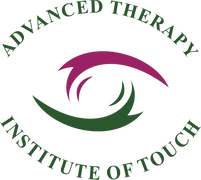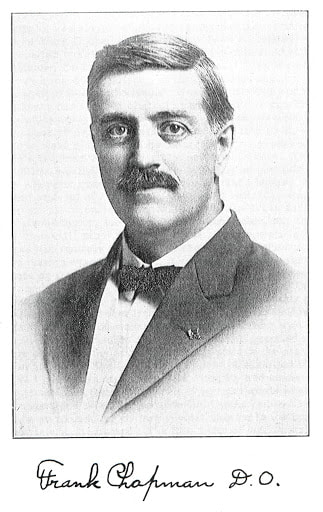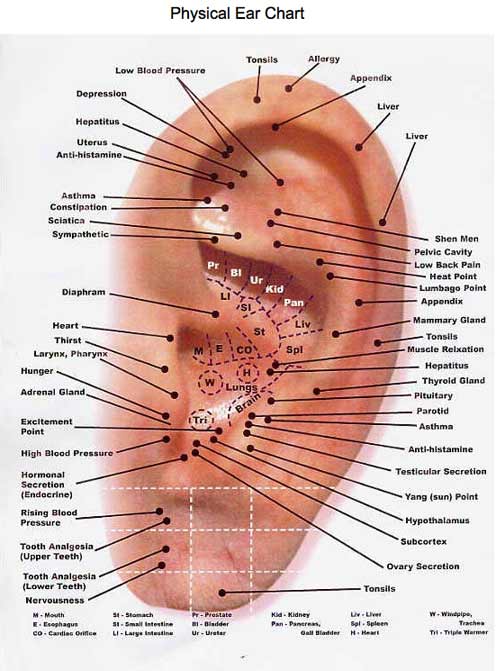Chapman's Neurolymphatic Reflexology
One hundred years ago, osteopathic practitioner Dr. Frank Chapman recognized and used reflex points that correlated to the Chinese & Japanese Acupressure systems. He identified a system of points on the body where bound or reactive nerves impede the circulation of lymph fluid. These nerves are connected to various internal organs and skeletal muscles. When these organs or muscles are stressed (for example, by injury or disease), the connected nerves contract and impede the flow of lymphatic fluid. This can be observed by physically palpating the Chapman’s Neuro-lymphatic Reflex points and feeling the stagnant lymph.
A positive result (represents an imbalance in the distal organs including the adrenals, lungs, kidneys, and intestines as well as muscles and muscle groups) is indicated by a small bump, variously described as being the size of a BB, a tapioca bead, or half of a pea. The bumps are smooth and solid but not hard. They are loosely anchored to the area; in other words, they move but not much. These points might also feel ropy. They do not radiate pain the way that trigger points do, instead, the pain is local within the point itself.
The bump itself, along with the pain response, indicates a reduction of nerve flow with the connected organ or muscle. In this way, Chapman’s Neurolymphatic Reflexes are an assessment tool.
Perhaps more importantly than as an assessment tool, Chapman theorized, appropriate stimulation of these points offers an avenue to balance the organs, nervous system and lymph system. Thus, creating a holistic approach to various physical dysfunction and pain. This stimulation, not to be confused with massage, releases the bound nerves and improves the circulation of lymphatic fluid. Lymph fluid is an important component of the immune system.
Chapman theorized the stimulation and movement of lymph improved immune response. In addition, he believed when the bound-up nerve was released, the function of the connected body part was also improved. Chapman recorded hundreds of case studies that showed efficacy and proved many of his theories. Chapman’s Neuro-lymphatic Reflex Points offer not only a balancing tool but also an avenue for helping the effected organs to more optimal function.
What then constitutes appropriate stimulation of Chapman’s Neuro-lymphatic Reflexes? For assessment and subtle treatment, the points are stimulated for about 15 seconds. This pressure is directed on top of the skin going ever so lightly into the lymph to check for a small bump or bead type structure under the skin. This allows the practitioner to locate the reflex point and helps the practitioner or individual determine whether the client has a pain response. If there is a pain response then additional balancing is required to alleviate the blocked lymph.
For a stronger effect on the point there are three ways to release Chapman's Reflex points.
First ~ Pandiculation. The practitioner can either use directed compression or traction at an angle that impacts the point in a specific way. The angle, along with the catalyst allows the lymph fluid to move and releases it from the area and discontinues blocking the nerve ganglia. The angle is kind of like wringing out a sponge. Pandiculation is by far the most effective in working with Chapman's system. Pandiculation is also incredibly effective when working in the Chinese Ethnomedicine & Japanese Ethnomedicine Systems.
Second ~ Abrupt Stimulation. This technique takes longer, can be painful and can take between 30 seconds and two minutes per point location. It is abrupt stimulation of the point with the fingertips pressing in a 90% angle into the Tsubo/Psubo. The stimulation directly impacts the lymph and nerve ganglia where the lymph can become stuck. This system is not as gentle as Pandiculation and can lead to a strong detoxification process for the client. If done incorrectly or too many points are stimulated, it can produce uncomfortable results for the client and make them feel nauseous and sick to their stomachs.
Third ~ Lymph Pushing ~ light tapping or smoothing out the actual lymph fluid within the reflex point. A light touch is both necessary and sufficient because lymph structures are delicate and very close to the surface of the body. Again, because we are moving the fluid, this method should be handled with great perception and care.
Caution should always be taken as some clients have an uncomfortable reaction to the treatment. This is called Menken in Japanese Ethnomedicine. This is not in any way a contraindication and in Eastern Philosophies is expected. It is a detoxification process. Always remember, less is more with Chapman's. Only stimulate about 3-5 points per day and in an order from the legs upwards.
Some clients have what is called a menken in Japanese Ethnomedicine where the points put them into a detoxification spiral. The client might feel a little lightheaded as the body detoxifies. Always speak to your Doctor before starting any self-care program or seeking complimentary and holistic services.
A knowledgeable practitioner will be able to guide their client through a series of pandiculations, abrupt stimulation and lymph pushing that will release the Chapman's reflexes. A professional will not simply follow a protocol, but will design a session specifically for that persons body, biochemistry and historical health imbalances.
Chapman did not share his work with the public. I have often theorized it was because his work stemmed from acupressure & acupuncture charts that were not favorable and considered pseudo-science at the time. In some religious settings, acupressure & acupuncture were even considered demonic. Today, mainstream and even modern medicine are beginning to recognize these practices as valid and efficacious with case studies showing positive results.
Instead of sharing his body of work and where he got the points from, Frank Chapman passed away with the majority of his work & knowledge unpublished. After his death, Chapman's partner Dr. Charles Owens wrote about the Neuro-lymphatic Reflexes in the book "An Endocrine Interpretation of Chapman’s Reflexes", (1937). The book was a brief compilation of Chapman's notes, research, case studies and illustrations.
In this work, Owens provided charts of 50 distinct reflexes. Many of these points are located on the front side of the body between the ribs where the ribs meet, the sternum, and on the back of the body along the spine. Chapman's Reflexology spinal points are the same as the Shu Points in Chinese Acupressure & Ethnomedicine. Chapman's torso points are the same as the Alarm Points in Chinese Acupressure & Bo Points in Japanese Shiatsu & EthnoMedicine. Clients can stimulate these points or have a practitioner do so.
Over the years, Chapman's Neurolymphatic Reflexology System was almost lost completely because of laws that limited this practice even though it was not dangerous or harmful to the public.
Quite the opposite, it is effective in balancing the body.
At the same time that Chapman's Reflexology Micro-System was criminalized, almost all other holistic health practices including herbalism, reflexology, homeopathy, nutrition, yoga and many other alternative health care practices were outlawed as well. This criminalization of all holistic health was due to Medical Practice Acts passed in almost every state in the 1920's & 1930's. These laws made all alternative health illegal. Even today, complimentary and adjunctive holistic practices are only legal in 10 states.
Not until 2013, after 14 grueling years of trying to change the law, did we finally accomplish that goal in the state of Colorado. Myself and a handful of extremely dedicated individuals were able to reverse the laws that made all holistic and adjunctive health care practices illegal in the state of Colorado & New Mexico. This included Chapman's Reflexology system.
During the time of our legislative challenge, I could actually practice legally in the state of Colorado under my professional licensing. Even though I could practice legally, I felt to exclude any healing modality from a human being (and their animals) was a crime against humanity.
An ethical healing act between two people should never be criminalized. I am excited that herbalism, nutrition, Chapman's & many other healing modalities are once again legal, but we have many states to go. To date there are only 10 states where holistic health modalities are legal.
Today, there are very few instructors that know Chapman's Neurolymphatic Reflexology well. I was very blessed over 25+ years to have learned, practiced and now teach this impactful system. As a historian, and now instructor of Ethnomedicine, it has been my life-long passion to find practices that are highly effective. I have spent a lifetime learning as much as I could from familial and lineage based mentorship and acedemic learning so these modalities are not erased permanently from our body of knowledge. It's a privilege and honor that I might share what I know with anyone who might want to learn. It is also a great success that we now all have the freedom to do so.
A word of warning... We could lose these freedoms very easily with the stroke of a pen. Today, tomorrow or the next legislative cycle we are always being threatened to lose our health freedom laws.
Six years later, I still have to actively work to uphold your rights to health care choices. Once a law is passed that is when the true work begins to maintain it. Every year, I fight at the capitol against many organizations, groups, professionals and individuals that would take your basic right to health away from you once again. There are many who want to criminalize the human act of healing.
What is most unfortunate is many people who fight against Health Freedom Laws in the United States are holistic practitioners themselves. Actively promoting legislation that would create monopolies which benefit them financially while excluding those with great knowledge and skill. For more information on maintaining the legality of holistic practices please join our facebook group HERE and sign up for our newsletters by returning to our homepage.
We have made great strides in upholding your rights to choose holistic health care and we will continue to do so, however, we do need your help. The opposition gets stronger every year.
For now, I'm excited that Chapman's Neuro-lymphatic Reflexes are out in the public domain again and are actively helping people to have stronger and better lives.
Until next time,
Kim M. Green, Founder
www.advancedtherapyinstitute.net
Kim is the Founder and Senior Instructor at Advanced Therapy Institute of Touch. She teaches laypeople and professionals alike advanced bodywork techniques which utilize Integrative Meridian Therapy, Hara Assessment, Somatic Trauma Release therapies, Japanese Ethnomedicine & Chinese Acupressure and Musculoskeletal Rehabilitative forms of bodywork. She loves teaching practitioners to assist their clients in releasing long-held chronic injury, traumas or somato-emotional patterns that reduce a persons ability to enjoy their lives fully. At ATIT, we believe "All Things Are Possible!" Check out our School Tour. Please go to the links FMI on taking ATIT's Reflexology Certifications or Massage Therapy Certification.







 RSS Feed
RSS Feed